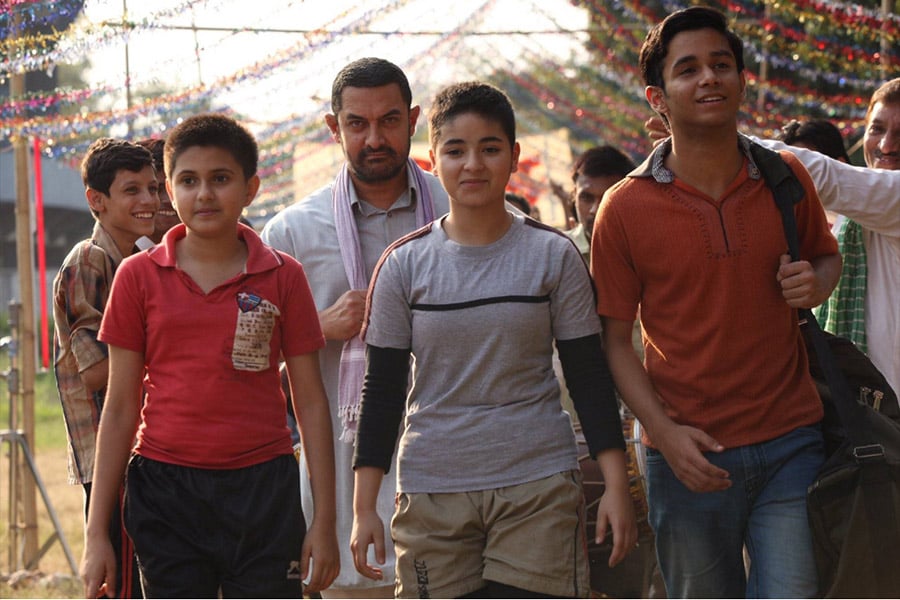
Dangal is Bollywood's highest grosser and at 51, Aamir Khan Indian cinema's beacon of hope
The biopic on former wrestling coach Mahavir Singh Phogat beats the record set by the actor's previous film, PK

It’s been worth the wait and effort for Aamir Khan. The 51-year-old actor’s latest release, the Nitesh Tiwari-directed Dangal (2016), has become the highest grossing Hindi film to date with box office collections of Rs 345.3 crore as of January 9. The sports drama, inspired by the life story of former wrestler and Olympic coach Mahavir Singh Phogat who encourages his daughters Geeta and Babita to take up the sport and excel at it in a conservative village in Haryana, beat the record of Khan’s previous release PK (2014) – which had total earnings of Rs 340.8 crore. What’s more, Dangal crossed the milestone of Rs 300 crore in a record 13 days in India, four days less than the time it took for PK to reach the landmark. Co-produced by Disney India and Aamir Khan Productions, Dangal, made on a budget of approximately Rs 90 crore, is on its way to enter the uncharted territory of Rs 350 crore for a Bollywood film.
Of the top five Bollywood grossers ever – the others being Bajrangi Bhaijaan (2015, Rs 320.34 crore), Sultan (2016, Rs 300.45 crore and Dhoom:3 (2014, Rs 284.27 crore) – three feature Aamir Khan in lead roles. The statistic is a testament not just to the actor’s business sense, but also his ability to raise the bar with his choice of films. It doesn’t matter to him if there’s a hiatus of two years before he appears on the big screen, like the gap between PK and Dangal, as long as he is offering something new and giving it his all to the project on hand. Consider that for Dangal, he took the risk of playing an ageing, pot-bellied father to two grown-up girls. While it may appear as a logical thing to do for an actor in his 50s, most of his contemporaries are still wary of playing their age on screen.
To look the part, Khan put on 27 kilos and went from 70 kg to 97 kg with 38 percent body fat. He insisted that the director shoot the few scenes in which he appears as a professional wrestler later so that he had enough motivation to lose the weight he had piled on. The fact that his lean avatar with 9 percent body fat occupied just a few minutes of screen time was inconsequential. The actor underwent a remarkable physical transformation to make his on-screen character appear believable on celluloid. The makeover was complemented by relentless training by a professional coach to get the nuances of wrestling right.
The physical metamorphosis aside, Khan did a bigger service to Indian cinema by choosing to do a film like Dangal and giving it nearly two years of his career. His presence and the subsequent success of the film meant that a country obsessed with cricket was introduced to a relatively sidelined sport and the inspiring story of Phogat and his two wrestler daughters, Geeta, a 2010 Commonwealth Games gold medallist, and Babita who won a silver medal at the same sporting event. The portrayal of a strict father-cum-coach who pushes his daughters to pursue his dream of winning a gold medal for India in wrestling was fraught with risks such as being viewed as a tyrant. There was a possibility of him being criticised for imposing his wishes on his children and being ruthless with them in his pursuit of his ambitions. But Khan put aside such concerns. The neatly scripted story with a dose of family drama, humour and patriotic fervour had the viewers hooked to the screen till the end. Though an entertainer, Dangal also addressed issues like gender stereotypes and the rot that’s prevalent in our country’s sports administration.
Since the turn of the millennium when Indian cinema witnessed a positive churn in terms of the diverse stories being told, Khan has led the change with memorable films like Lagaan (2001), Dil Chahta Hai (2001), Rang De Basanti (2006) and 3 Idiots (2009). He has had many firsts to his credit along the way: Ghajini (2008) was the first film to enter the Rs 100-crore club; 3 Idiots to touch the Rs 200-crore mark and PK the figure of Rs 300 crore.
Khan’s conscious effort to choose interesting, content-driven subjects and not stick to the tried-and-tested formula even in mainstream movies has set him apart from the rest. He is seen as a beacon of cinematic hope and someone who pushes the envelope with each film that he’s involved in. It’s not surprising that his popularity remains intact even when he’s not in the public eye in connection with his work. His penchant for doing one film at a time is legendary and keeps the expectations from the audience extremely high.
Dangal’s unprecedented success, both in India and overseas – it has earned Rs 663 crore at the worldwide box office and become the most successful Indian film in North America and Australia – has only strengthened Khan’s reputation as a game changer and a bankable star. As someone who’s passionate and madly in love with his craft, Khan effortlessly carries the mantle of being an actor who attempts something new and consistently delivers the goods. And that’s a refreshing change in an industry infamous for clones and stereotypes.
X















